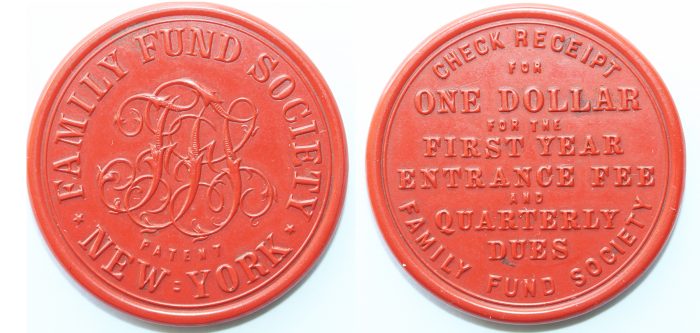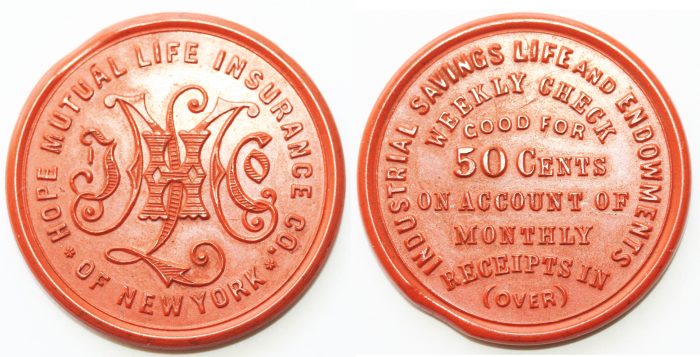When the Family Fund Society was established in New York City on February 14, 1884, it was founded as an insurance company (or “association,” as it was referred to), but with an interesting set of guidelines that were different from what you might expect. Members joined by paying an admission fee. Annual dues were collected to provide for the society’s operating expenses. If a member died and didn’t have enough money in their “death fund” at the time, each surviving member would be required to pay an assessment, based on the amount needed, within 30 days.
The society, which was located in the Stewart Building at the corner of Broadway and Chambers Streets, had 60 days to settle claims. This gave it ample time to receive the members’ assessments. Of the funds collected, 80 percent was allocated to paying the claim. The other 20 percent was set aside as a contingency fund.
Legal Trouble
That’s how the society’s plan worked, at least in theory. In reality it wasn’t quite the utopian arrangement it was portrayed to be. Claims weren’t always paid, and several lawsuits ensued. One of them was filed on behalf of James H. Darrow, a building contractor who lived in Brooklyn. He had joined on January 14, 1885, and died 11 months later by committing suicide while incarcerated at a jail in Ballston, New York. His wife filed a lawsuit, claiming that the society had “bound itself to pay to the plaintiff, within sixty days after the requisite proof of death of such member, $5,000,” as stated in the policy. The defendant argued that the company denied the claim on the grounds that the society’s death fund wasn’t sufficient to pay it at the time of the death, and also because he died by suicide. The Court of Appeals of the State of New York ruled against the society.
In October 1891, the New York Supreme Court dissolved the Family Fund Society. During its short existence, the group issued an interesting 34mm hard rubber token. A large FFS monogram is in the center of the obverse, with FAMILY FUND SOCIETY around the rim above it, and PATENT/NEW YORK below. The reverse inscription reads CHECK RECEIPT/FOR/ONE DOLLAR/FOR THE/FIRST YEAR/ENTRANCE FEE/AND/QUARTERLY/DUES/FAMILY FUND SOCIETY. The token was made of three layers of rubber. The obverse and reverse are brick red, while the middle section is black. I can’t recall seeing another three-layer rubber token issued by an American company. However, many Latin American tokens were made by this process.

The Family Fund Society issued red rubber tokens with its monogram in the center on the obverse. (Photos: David Schenkman)
Hope Mutual Insurance Company
A very similar hard rubber token was issued a decade earlier by another New York City insurance company. The obverse design resembles that of the Family Fund Society, but it has the monogram HMLICO in the center, with HOPE MUTUAL LIFE INSURANCE CO. above, and OF NEW YORK below. The reverse inscription is INDUSTRIAL SAVINGS LIFE AND ENDOWMENTS/WEEKLY CHECK/GOOD FOR/25 CENTS/ON ACCOUNT OF/MONTHLY/RECEIPTS IN/(OVER). A similar token with a 50 CENTS denomination (pictured here) was also issued; both are brick red and 35mm.

Hope Mutual Life Insurance Co. issued this red rubber token with a 50-cents denomination. (Photos: David Schenkman)
Hope Mutual opened in 1869 and soon experienced financial difficulties. On December 31, 1872, the company transferred all its assets and property, which were valued at about $273,000, to the New Jersey Life Insurance Company. However, 10 years later, legal issues regarding its operation remained unresolved.
The firm also issued an embossed shell mirror, which is listed as NY-6420 in Q. David Bowers’s Token and Medal Society Guide to U.S. Shell Cards, 1867-1880. Its inscription consists of the company’s name and an address of 187 Broadway. Interestingly, an 1891 newspaper article concerning the financial woes of the Family Fund Society gives the same address, and although I haven’t found any other connection between the two companies, it seems unlikely that this is merely
a coincidence.
I listed the Hope Mutual tokens in my book Merchant Tokens of Hard Rubber and Related Compositions as NY 610-H25 and H50.
The Family Fund token is not listed because I wasn’t aware of its existence when the book was published in 1991. Since then, collectors have located a few examples. Catalogs like this are never complete. And even though I corresponded extensively with other collectors while writing the book, previously unknown tokens still surface occasionally.
I welcome readers’ comments. Write to me at P.O. Box 2866, La Plata, MD 20646. If a reply is desired, please enclose a self-
addressed, stamped envelope.
A version of this article appears in the February 2024 issue of The Numismatist (money.org).
